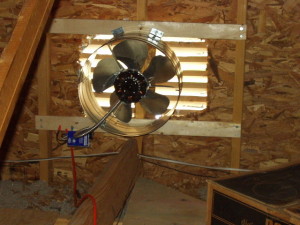Attic Fans: The Downside of Sucking Hot Air
Attic Fans: The Downside of Sucking Hot Air

In theory, attic fans are installed to reduce cooling costs and to lower attic temperatures. However, in practice they lower attic temperatures but cause a plethora of other problems. But what exactly are attic fans? Attic fans are installed in the attic and used to expel hot air (you can learn morehere). Attic fans can be installed in the roof deck, gable ends, or in the ceiling deck of the building. For this particular blog we are going to emphasize two different applications: attic fans and whole house fans. Attic fans differ from whole house fans because they are installed in the roof deck or gable ends, while whole house fans are installed in the ceiling deck.
How they work
Attic fans are supposedto vent the hot air in your attic to outside of the building. In order for this to work, you need some kind of makeup air source (preferably vented soffit or vented gable ends). Also it is needed for the ceiling deck to be completely air sealed. If you do not have makeup air vents, the attic fan will draw a negative air pressure from wherever it can and cause stack induced pressure. To find out more about stack induced pressure, visit this previous blog.
Most of the time stack induced pressure occurs from the unsealed ceiling deck, which in turn means the inside of the house. When this happens, multiple things occur: back drafting water heaters, furnaces, etc. (all bad things). This can draw carbon monoxide into the living area of a building. This can be detrimental to whomever is inside the building.
Whole house fans can cause the same problems and more. Whole house fans are mounted in the ceiling and they directly draw air from the living area. They need some kind of makeup air to work properly as well. Most of the time, both systems are installed because of high inside room temperatures caused by insulation and air sealing issues. Depending on the climate, outside temperature, roof color, and amount of venting, attics can reach temperatures well over 120 degrees Fahrenheit during the hot summer months.
What this means for you
Any insulation you have in your attic is going to have to work harder. Think of it this way: if the outside temperature is 85 degrees Fahrenheit and you have your air conditioner set at 70 degrees Fahrenheit, your air conditioner will have to lower the temperature by 15 degrees. If your attic is 120 degrees Fahrenheit, you will have to lower it 50 degrees. That’s a big difference! The best way to lower the attic temperature is to create a conditioned attic. To read more about conditioned attics, read this previous blog.
Another large problem with whole house fans is that they leave a big, uninsulated hole in your ceiling deck. Depending on the season, this can let hot attic air down into your house. It is even a bigger problem during winter: it lets warm, moist air into the cold attic area. This air then freezes on the roof underside causing frost. If this persists for a long enough period of time, ice will form on the roof underside. When the ice melts when it warms back up again, the melted ice will drip causing a leak in your ceiling. This video will show you the big hole in the ceiling created by the whole house fan:
It is a good idea to cover the whole house fan with a box made from polyiso board similar to this:
When it comes to attic fans, let the professionals at KC Spray Foam help you out. Our employees have extensive building science training, and we have been to many different job sites investigating building problems. Most likely we have already seem the problems you are facing and we can suggest an effective remedy. Contact us today!
About the author
Mark grew up in Winterset, Iowa: the birthplace of John Wayne and the home of Madison County Covered Bridges. He lived on a small acreage where they raised cattle, sheep, and chickens. During his youth, he raised and showed cattle with the local 4H program.
Mark’s first paying job was working at the local lumberyard after school and on weekends. After he graduated from Winterset High School he pursued the agricultural field by working on a large farming operation eventually working his way up to the manger position and partner. He also had a long career in the transportation industry.
Mark continues to own and oversee the operations of Iowa Spray Foam in addition to KC Spray Foam & Coatings.
Mark resides in Lee’s Summit, MO with his wife Tina and three of their four children. Their oldest lives and works in the Kansas City area as well.